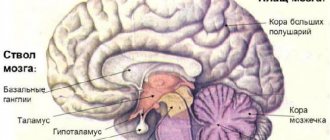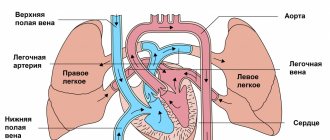Motor speech area of the cerebral cortex, Broca's area
The motor speech area is an area of the cerebral cortex located in the posterior
section of the inferior frontal gyrus of the dominant hemisphere anterior to the cortical centers of movements of the lips, larynx, and tongue. When the motor speech area is damaged, motor alalia or motor aphasia occurs (motor alalia or motor aphasia syndrome).
Frontal lobe
Returning to the question of which part of the brain is responsible for speech, it is necessary to dwell on the study of the frontal lobe. First of all, there is a statement that the left hemisphere of the brain is responsible for the ability to speak. Speech centers are located here.
The frontal part of the cerebral hemispheres is of great importance in human daily life. She is responsible for:
- The nature of thinking.
- The process of urination.
- Maintaining the body in an upright position.
- Motivation and behavior control.
- Speech and handwriting.
The frontal lobe takes responsibility for the semantic construction of human speech.
Sensory speech area of the cerebral cortex, Wernicke's center
The sensory speech area of the cerebral cortex is an area of the cerebral cortex in the posterior part of the superior temporal gyrus of the dominant hemisphere. The term "sensory" comes from the Latin word "sensus", which means "feeling, perception, sensation". A synonym for the sensory speech area is Wernicke's center, Wernicke's area. When the sensory speech area is damaged, sensory alalia syndrome or sensory aphasia occurs.
When the sensory and motor areas of the cerebral cortex are damaged, sensorimotor alalia or sensorimotor aphasia occurs simultaneously.
Different opinion
The development of neuroimaging allows us to make the assumption that the functions that scientists previously thought were performed by Wernicke’s lobes are carried out by the temporal lobes. There are theories that claim that the inferior and middle temporal gyri process speech information. Also, a small portion of the temporal gyrus functions in speech recognition and processing. But these are just assumptions. Let's move on to the research results.
Several years ago, New York University and its medical center questioned the achievements of Brock and Wernicke, who observed people who had suffered a stroke. Scientists studied the activity of organs in completely healthy patients using modern instruments - a magnetic resonance imaging scanner, the work of which is based on observations of blood circulation during various tasks. The results led to the conclusion that the anatomy of the speech centers is not at all the same as it was believed for a century and a half.
The electrodes were applied directly to the surface of the cerebral cortex, which makes it possible to obtain a highly accurate picture with good resolution.
No one drilled into anyone’s skull; everything was done with the consent of the patient, who had to open the skull to treat any neurological abnormalities.
Some of those who agreed to the study had electrodes attached to one of the hemispheres, and some - to both. During observation, they listened to speech, repeated it to themselves and out loud. Moreover, among the words there were not only ones familiar to them, but also invented ones that did not carry meaning. Unknown syllables made it possible to separate the functions of pronouncing speech and understanding the meaning of phrases.
As a result, the centers that were the most active were identified. They are located in both hemispheres almost equally. It was also concluded that the speech department is less complex than the language department. The latter is responsible for understanding, processing information and composing logical phrases, and not just pronouncing words or syllables, like speech. That is why children utter the first inexpressive syllables before they understand the speech of strangers.
Treatment of damage to speech zones in Saratov, how to improve the functioning of speech zones
Sarklinik provides comprehensive conservative treatment of the speech areas of the cerebral cortex in children (boys and girls), adolescents (boys and girls), adults (men and women) in Saratov, Russia. At the first appointment, the doctor will tell you what reflex massage of speech zones is, what new advanced methods exist for restoring speech disorders; how to treat pathology of the motor and sensory speech zones, how to restore and improve speech. What happens when a pulsed magnetic field is applied to the speech centers in the cerebral cortex in Russia, does this technique always help? What new methods exist for stimulating speech centers that give 95% results? How to really improve the work of the Wernicke center, how to activate the Wernicke area? What is Broca's center? How to increase a child’s vocabulary in Russia? How to improve the impressive (sensory) and expressive (motor) speech of infants, preschoolers, and schoolchildren? Where to treat mental retardation, and what to do if speech zones are disrupted, how to treat speech disorders in Saratov . On the sarclinics website you can ask the doctor a question online and read reviews about the treatment of children.
Big-headed Mickey Mouse
Modern methods of molecular biology make it possible to “transplant” genes from one organism to another. It is possible to insert human FOXP2 into the genome of another animal to understand what benefits this variant of the gene provides in brain function.
The very first work in this direction was carried out in 2009 [12]. The object of the scientists' research was mice in whose genome the “mouse” version of Foxp2 was replaced with a “humanized” one. It should be clarified that it was not the whole gene that changed, but only two nucleotides that determine the difference in the amino acid sequences of the human and chimpanzee FOXP2 protein (the mouse protein differs in one more amino acid). All mice with the “human” gene (hum) survived and were able to leave offspring. The study compared another type of mouse (wt/ko), in which one allele of the Foxp2 gene belonged to a normal mouse (wild type, wt), and the other was a variant of the gene found in people with speech disorders (ko). “Ordinary” mice were also studied, and their results were taken as a conditional norm, but were not taken into account in the discussion.
Figure 6. Dopamine levels in the brains of two groups of mice. In hum mice, compared to wt/ko mice, less dopamine is produced in different brain structures.
[11]
“Humanized” mice showed less exploratory activity than wt/ko mice, but at the same time they more often participated in group contacts. In hum mice, compared to the wt/ko group, the level of dopamine in the brain [13], the main “motivating” neurotransmitter, was lower (Fig. 6). There may be a direct link between dopamine levels and exploratory behavior. The reduced level of dopamine in hum mice does not create motivation to act as strongly and in such quantities as in wt/ko mice. However, this is not to say that this is bad. In a sense, hum mice can be said to be less fussy and more focused than their wt/ko counterparts. In the striatum (an area rich in dopamine neurons) of hum mice, neurons with longer dendrites were found - processes that transmit information to other cells. In addition, the normal human variant of Foxp2 increased neuroplasticity in the brains of hum mice. In general, it seems that the “humanization” of the gene streamlined the functioning of the nervous system of hum mice due to finer tuning of dopaminergic signal transmission.
Another study by a group of European scientists analyzed different types of learning in mice with the human version of Foxp2 [14]. There are two fundamentally different types of learning - declarative and procedural. Declarative learning requires conscious control over each action and awareness of its meaning. Procedural learning occurs through automatic repetition of actions. In the experiment, normal mice and mice with the human Foxp2 variant had to navigate a maze using different types of training. Procedural learning occurred by requiring the rodents to always turn right to find a treat. In another version of the task, which involved declarative learning, the treat was always placed in the same part of the maze, but since the mice were launched into it from different directions, they had to take this circumstance into account and remember the location of the reward, relying on additional external cues.
When the types of learning were examined separately, there was no difference between the two groups of mice: both groups performed about the same on the task. Hum mice gained a clear advantage over normal mice if they were first trained in a “declarative” maze and then moved to a “procedural” maze. Humanized mice appear to improve the transition from declarative to procedural learning. According to experimenters, this feature of the functioning of the nervous system of mice may demonstrate changes in the brain of people that have adapted it to speech. Scientists, in particular, believe that in hum mice the balance of declarative and procedural learning is shifted towards procedural learning, while in normal mice it is vice versa. The phenomenon of rapid switching from declarative learning to procedural learning with an increase in the success of the latter is called proceduralization by researchers.
This effect of amino acid substitutions in Foxp2 became possible because this protein regulates a large number of genes and ultimately controls the development of the striatum, a part of the brain necessary for learning. The human version of Foxp2 in striatal neurons lengthens dendrites, and also increases long-term depression (V.L.) of signal transmission in neurons and neuroplasticity, which also has a beneficial effect on brain activity. Apparently, stronger connections are formed in the brain, which perform their function more reliably. The result of these changes is a better integration of learning processes into behavior patterns. Proceduralization does not speed up the “automation” of a skill, otherwise hum mice would gain a great advantage over normal mice already at the stage of isolated testing of different types of learning. It allows you to master a skill and subsequently learn similar actions at an accelerated pace, at an automatic level, that is, it “treads the path” for other information. In principle, this is very similar to learning to speak, when a child, having mastered the basics, begins to learn on his own, literally on the go, including constructing words independently.
Perhaps FOXP2's most notable contribution to the evolutionary history of our species is its proceduralization of our learning, which has simplified more than just speech. It could lead to more efficient creation of tools, the development of cooking methods, and the emergence of other important components of our culture. If you give free rein to your imagination, you can imagine that modern civilization arose thanks to two amino acid substitutions in the FOXP2 protein, and this is a rather exciting thought.
Treatment of speechopathy in Saratov, how to treat speechopathy in Russia
Sarklinik provides speech therapy treatment in Saratov , treatment of speech pathologies, speech disorders in children, boys, girls, teenagers in Russia. Sarklinik knows how to treat logopathies, how to cure logopathies, how to get rid of logopathies.
Treatment of alalia, treatment of aphasia, treatment of stuttering, treatment of speech delay, treatment of speech development disorder.
Sign up for a consultation. There are contraindications. Specialist consultation is required.
Photo: (©) Bioraven | Dreamstime.com\Dreamstock.ru
Related posts:
Enuresis in boys, treatment of enuresis in boys, nocturnal, daytime enuresis
What is the proper weight (body weight) and height of a child by month, year: table, norms
Neuropsychic development of children, assessment, diagnosis, treatment
Calomasania in children: causes, treatment in Saratov, how to treat calomasania in Russia
If a patient with Tourette syndrome does not want to be treated, what to do?
Comments ()
Causes of speech impairment in children
In order for a child to fully develop, it is necessary to sufficiently develop his speech apparatus and avoid factors that negatively affect this. These include:
- genetic predisposition - the mechanism is not really explained anywhere, but it is almost impossible to avoid this on your own, you can only rely on nature;
- problems with the organs of hearing - if a person hears speech unintelligibly, it will also be reproduced by him;
- inhibition in mental development;
- physical deviations in the perception of the world due to pathologies of the corresponding brain centers;
- the effect of certain medications or the combined use of several medications at the same time;
- insufficient attention from parents and untimely access to specialists.
Everything in the body has its own time, and if the child does not start speaking in time, there is a high probability that he will never be able to do this even with the help of modern medicine, since time has been lost. An example of this is Mowgli children: if a child’s puberty occurred in the wild, no one and nothing can socialize such a child.
Temporal lobe
The role of this part of the brain is not so extensive, but much more narrowly focused. The temporal lobes are located in both the left and right hemispheres of the brain, which affects their basic functions.
The left temporal lobe is responsible for:
- Perception of sound information.
- Short-term memory.
- Selection of words during a conversation (role in speech formation).
- Synthesis of visual and auditory information.
- Interaction of music and emotions.
The right temporal lobe is responsible for:
- Facial expression recognition.
- Perception of rhythm and musical tone.
- Perception of speech intonation.
- Recording visual facts.
This part of the brain allows a person to understand by the intonation of the interlocutor’s speech about his emotions and attitude to the issue under discussion.









